LED therapy may shield you against strokes by promoting cellular recovery and reducing neuronal death. It enhances cell viability and boosts energy production, essential for brain health. Clinical studies show significant improvements in stroke recovery, including reduced infarct size and better functional outcomes. This noninvasive treatment activates pathways that reduce inflammation, preserving tissue integrity. Patients often report improved well-being and independence after therapy. Plus, its established safety profile makes it an appealing option for stroke rehabilitation. Your journey to understanding its broader benefits can uncover even more about how this innovative treatment can aid your recovery.
Mechanisms of LED Therapy
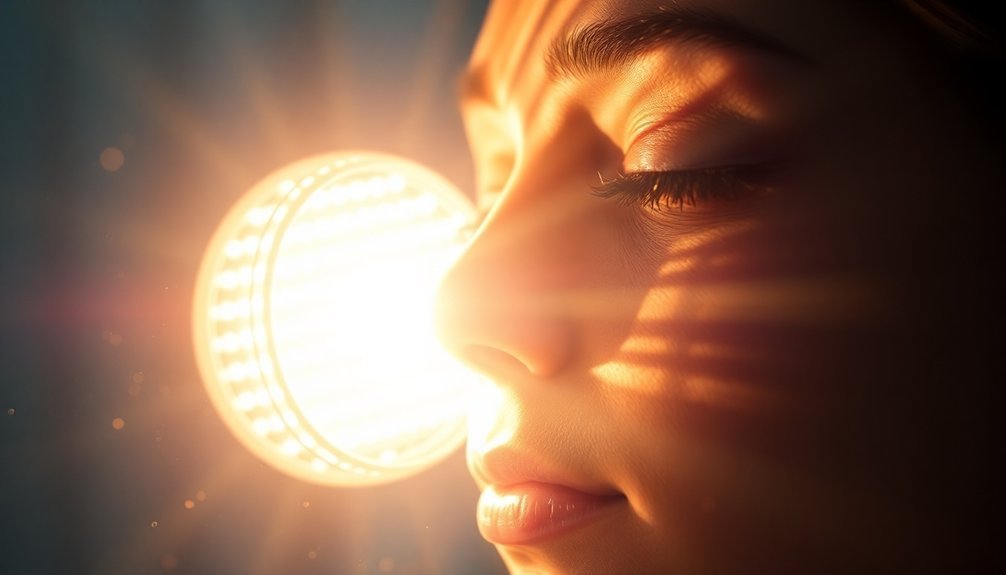
LED therapy leverages various mechanisms to promote cellular responses that can be beneficial, especially following a stroke. One of the key effects is increased cellular proliferation, particularly in neural progenitor cells, which can help in recovery. By enhancing cell viability, LED photobiomodulation (PBM) encourages healthier cellular function, though it's worth noting that these benefits may not always translate consistently in living organisms.
The energy density and specific wavelengths of the light are crucial, as different levels can yield varying therapeutic outcomes. For instance, ideal wavelengths around 830 nm or 610 nm and exposure times like 20 or 30 minutes enable effective cellular responses. Moreover, the therapy also exhibits the potential to promote neuroprotection by activating cytochrome C oxidase in mitochondria, further enhancing cellular energy production.
You'll also find that LED therapy impacts inflammation, playing a role in reducing neuroinflammatory responses. By suppressing the NLRP3 inflammasome and down-regulating inflammatory cytokines, LED PBM minimizes damage to neural tissue.
Additionally, it reduces the activation of neutrophils and microglia in affected areas, facilitating a more robust healing environment. Overall, these mechanisms work synergistically to promote recovery and sustain cellular function, making LED therapy a promising avenue in post-stroke rehabilitation.
Neuroprotective Benefits
Light therapy provides neuroprotective benefits that play an important role in stroke recovery. By using red light therapy, you can help reduce neuronal death, which is vital after an ischemic stroke.
Animal studies show that this therapy improves functional outcomes, particularly by mitigating secondary injury mechanisms in the acute phase. You'll be pleased to know that LED therapy decreases infarct size associated with ischemic brain damage, promoting increased neuronal survival.
Moreover, this therapy attenuates neuroinflammatory responses by down-regulating pro-inflammatory cytokines and suppressing the NLRP3 inflammasome. These effects greatly contribute to tissue preservation following a stroke. RLT enhances neuroplasticity, which is crucial for the brain's ability to adapt and recover post-injury.
Enhanced cellular function is another benefit. As red and near-infrared light photons stimulate mitochondrial function, they increase ATP production, fostering cellular energy.
This increase in cellular energy results in reduced cell death and improved cerebral metabolic function. By minimizing oxidative stress and inflammatory responses, LED therapy not only supports recovery but also enhances overall brain health.
Ultimately, these neuroprotective benefits stand to make a meaningful difference for stroke survivors, promoting effective recovery and better cognitive function.
Clinical Evidence Overview
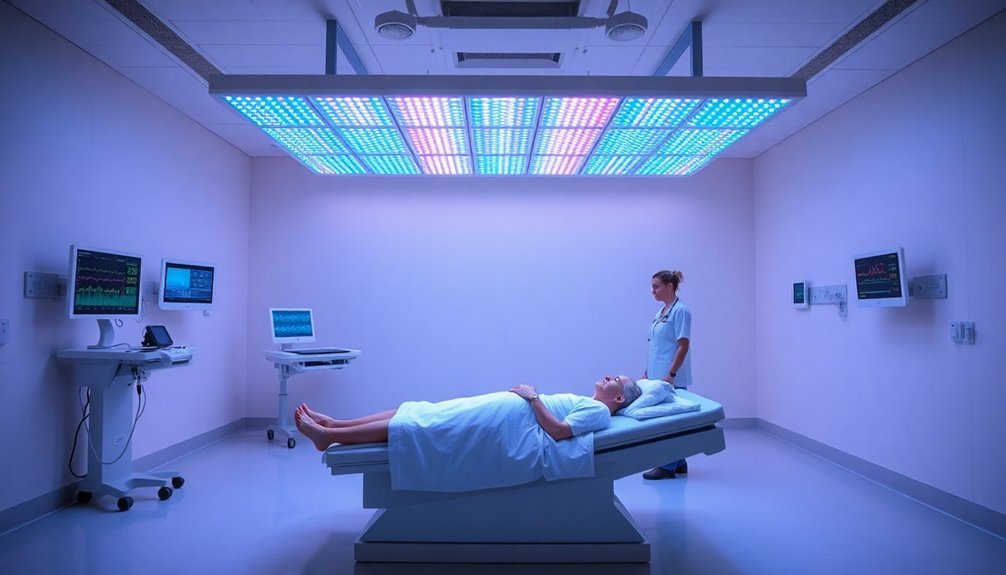
Clinical evidence surrounding light therapy for stroke recovery highlights promising outcomes from recent studies. The NEST-1 study, involving 120 ischemic stroke patients, demonstrated significant improvements in NIHSS scores within 90 days. This double-blind, randomized trial showed that after receiving LED therapy, participants not only reported better functional outcomes but also exhibited noticeable reductions in infarct size when compared to control groups. Additionally, the findings from this study indicate that the NeuroThera Laser System may play a crucial role in enhancing recovery for patients receiving treatment beyond traditional time constraints.
Here's a summary of key outcomes from relevant studies:
| Study | Outcome Measure | Results |
|---|---|---|
| NEST-1 | NIHSS Scores | Significant improvement |
| NEST-1 | mRS & Barthel Index | Enhanced functional recovery |
| LED-PBM (animal) | Infarct Size | Reduced size with neurological improvement |
| LED-PBM (animal) | Functional Recovery | Positive fMRI and behavioral outcomes |
| NEST-1 | Adverse Events | No significant differences |
With consistent results across both human and animal studies, the evidence positions LED therapy as a potential breakthrough in stroke rehabilitation. Future research aims to validate and expand these findings for broader clinical applications.
Effective Treatment Protocols
Effective treatment protocols for LED therapy in stroke recovery hinge on timely intervention and precise application techniques. For ideal results, you should initiate treatment within 24 hours of stroke onset. Studies like NEST-1 show the mean time to treatment often exceeds 16 hours, indicating a need for urgency.
Early intervention greatly minimizes neurological damage and enhances outcomes, while delays beyond 24 hours mightn't lead to meaningful recovery.
When applying LED therapy, focus on light properties such as wavelengths between 600–1100 nm to guarantee effective penetration without thermal damage. Standard energy density should range from 1–30 J/cm², and various modes, including continuous and pulsed light, can be effective.
Transcranial PBM remains the go-to, delivering light non-invasively, though other methods like internal light-based therapy may also be considered.
Lastly, multiple irradiation sessions each lasting under 60 minutes could be necessary to maximize recovery. Throughout treatment, evaluate patient progress using established outcome measures such as the NIHSS or modified Rankin Scale to gauge efficacy.
Adopting these rigorous protocols can greatly influence stroke recovery through LED therapy.
Safety and Noninvasiveness
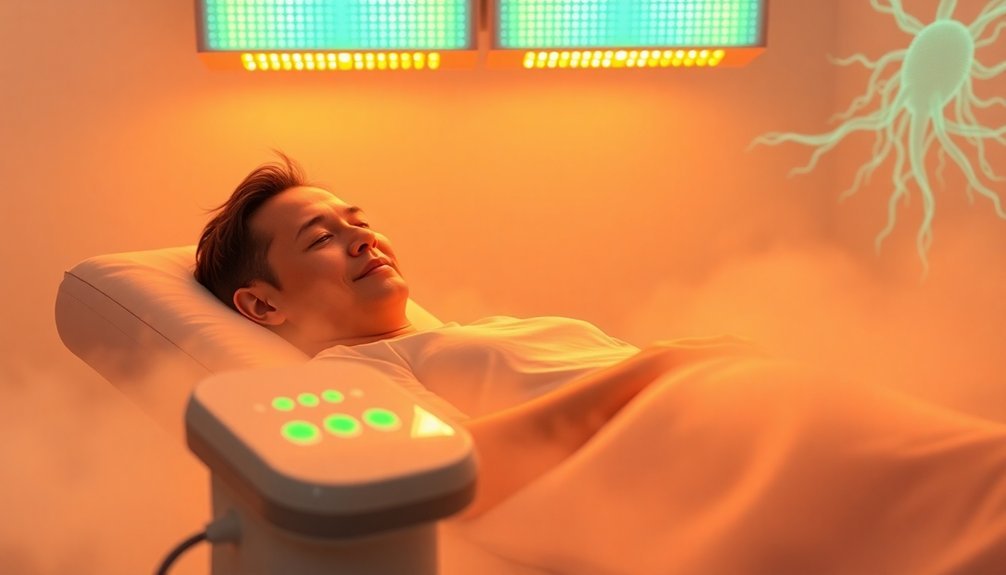
When you consider LED therapy, you'll find it stands out as a noninvasive treatment option that eliminates the need for surgery or device insertion.
The application process is painless, ensuring your comfort during each session.
Plus, with minimal side effects reported, this therapy presents a safe choice for supporting stroke recovery.
Noninvasive Treatment Method
Harnessing the power of LED therapy, researchers have focused on its remarkable safety and noninvasive nature as a treatment for strokes. This approach presents several compelling advantages, setting it apart from traditional methods.
- Minimal Risk: Since LED therapy relies on laser light rather than chemicals, you don't face typical toxic side effects. The treatment leaves your body after application, avoiding residual effects that can complicate recovery.
- Lower Complications: With its noninvasive nature, the risk of complications linked to surgical procedures drastically decreases. You can benefit from enhanced brain blood flow without the need for invasive interventions.
- Established Safety Record: LED therapy's well-documented usage in clinics, such as with Lasik eye surgery, reinforces its safety profile. The low-power, invisible laser light doesn't generate heat, minimizing any potential harm.
This combination of factors makes LED therapy an attractive option.
By focusing on the core issue of endothelial cell dysfunction, it targets the heart of stroke recovery without the drawbacks of more invasive or chemical-laden treatments.
It's a promising step forward in stroke management.
Painless Application Process
LED therapy not only offers a noninvasive approach but also guarantees a completely painless application process. You'll likely find the treatment experience quite relaxing, as users often describe it this way.
While you might notice a slight warmth during the session, it won't cause any discomfort, making it easy to incorporate into your routine.
One key advantage of LED therapy is its safety profile. Since it doesn't use ultraviolet (UV) light, there's no risk of burning or damaging your skin. This allows people of all skin types to benefit from the therapy with no recovery time needed afterward.
You can resume your daily activities without worries.
When using at-home devices, you can confidently follow the manufacturer's instructions to verify proper use. Most devices are equipped with safety goggles to protect your eyes from the bright lights.
Plus, looking for products that are "FDA cleared" or "FDA approved" guarantees extra peace of mind regarding safety.
Minimal Side Effects
You might be surprised to learn that LED therapy is remarkably safe and well-tolerated, making it an appealing choice for those seeking treatment for strokes.
Its non-invasive nature means you won't have to undergo any surgical procedures, and the absence of UV light eliminates risks like skin damage or burns. Most importantly, reported side effects are rare and usually mild.
Here are three key safety aspects to evaluate:
- Minimal Adverse Reactions: Clinical trials show LED therapy has minimal adverse reactions, with no significant severe complications linked to its use in stroke treatment.
- FDA Clearance: Many LED devices are FDA approved, ensuring a standard of safety and efficacy that gives you peace of mind.
- Neuroprotective Effects: LED therapy has demonstrated protective benefits for the brain, reducing inflammation and tissue damage, making it a beneficial option for individuals dealing with strokes.
Additional Therapeutic Benefits
Beyond its well-known applications in skin care and hair growth, LED therapy offers a range of additional therapeutic benefits that can enhance overall health.
For instance, when you use blue light therapy, you're effectively targeting acne by killing bacteria and reducing sebum production, while red light works wonders by stimulating collagen production. This can smooth out wrinkles and improve skin tone, addressing sun damage and pigmentation caused by UV rays.
Furthermore, LED therapy can accelerate wound healing. The red light boosts collagen production, enabling your body to more effectively heal wounds and reduce inflammation and redness. It proves beneficial after surgical procedures, speeding up recovery and making scars less noticeable over time.
If hair health is your concern, red LED light effectively stimulates hair growth, enhancing follicle activity and improving scalp conditions. You'll notice not just reduced hair loss but also thicker, healthier hair as well.
Additionally, LED therapy can address various dermatological conditions like psoriasis, rosacea, and even skin cancers, providing an overall boost in skin tone and texture.
These combined benefits make LED therapy a holistic approach to enhancing your well-being.
Impact on Brain Health
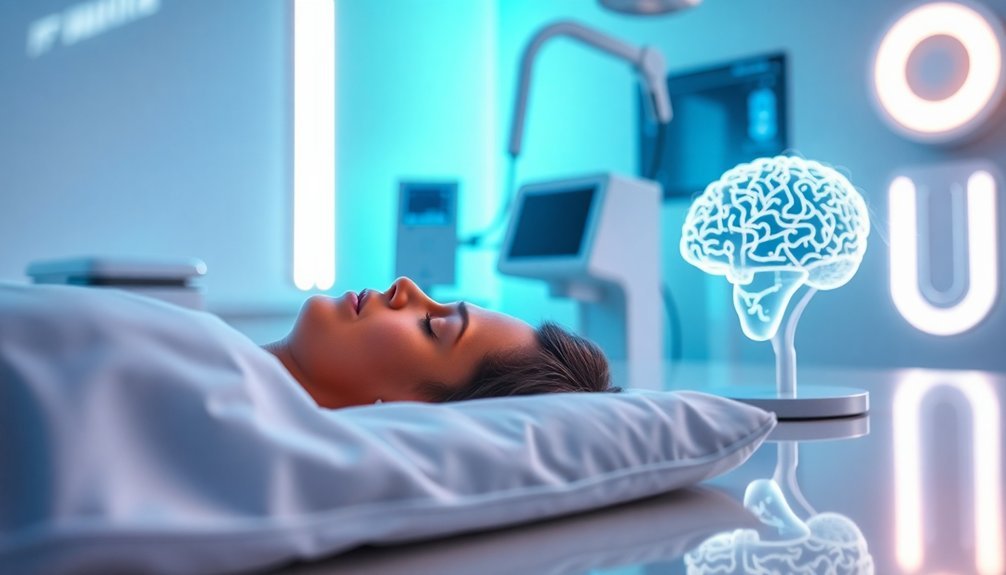
The therapeutic benefits of LED therapy extend beyond skin and hair health, making a notable impact on brain health as well. By utilizing red and near-infrared light, this therapy penetrates your skull, delivering crucial energy to brain cells. It enhances mitochondrial function, boosting ATP production, which aids in better cognitive function and memory.
Here's how LED therapy positively affects brain health:
- Improved Blood Flow: LED therapy increases regional cerebral blood flow and oxygenation, promoting enhanced brain function, as visualized on MRI scans.
- Neuroprotection: The therapy acts neuroprotectively, benefiting those with neurological disorders. It decreases neuronal cell death while fostering neurogenesis and synaptic plasticity, which are essential for recovery and memory.
- Reduced Inflammation: LED therapy suppresses the inflammasome, lowering neuroinflammatory responses and potential tissue damage, crucial for long-term brain health.
With its ability to enhance brain vigor and safety profile, LED therapy could become a cornerstone treatment for improving overall brain health, especially for individuals facing cognitive impairments or neurological conditions.
Embracing this innovative approach may open new avenues for maintaining robust brain function.
Future Research Directions
As you explore the future of LED therapy for strokes, consider the essential mechanisms of neuroprotection that need clarification.
It's also important to assess the long-term efficacy of these treatments to guarantee they truly benefit patients over time.
Finally, patient-centric outcome studies will help tailor therapies to individual needs, enhancing recovery rates and quality of life.
Mechanisms of Neuroprotection
Understanding the intricate mechanisms of neuroprotection offered by LED therapy could pave the way for transformative advancements in stroke recovery. This innovative approach harnesses multiple biological pathways, each contributing essential protective effects for neurons.
- Mitochondrial Enhancement: By increasing ATP levels through enhanced cytochrome c oxidase (CCO) activity, LED therapy promotes energy production critical for neuronal health. This boosts blood flow and oxygenation, addressing one of the primary aftermaths of strokes.
- Anti-Inflammatory Effects: LED therapy effectively reduces neuroinflammation by suppressing the NLRP3 inflammasome and decreasing pro-inflammatory cytokines. This results in diminished tissue damage, aiding recovery in the ischemic brain.
- Anti-Apoptosis Mechanisms: This therapy protects against cellular death by inhibiting caspase-3 activity and stabilizing mitochondrial membrane potential. By mitigating apoptosis triggered by neurotoxins, it safeguards neuronal survival in vulnerable conditions.
These mechanisms underline the potential of LED therapy in enhancing synaptic health and promoting neurogenesis, making it a promising avenue for future research aimed at minimizing stroke-related damage.
Long-Term Efficacy Assessments
Long-term efficacy assessments of LED therapy for stroke recovery require a thorough and systematic approach. To achieve reliable results, future studies should enroll larger, diverse patient populations, ensuring their findings can be generalized across various demographics.
Incorporating robust control groups—comparing LED therapy against standard treatments or placebos—is vital for validating the therapy's effectiveness. Randomized, double-blind trials will help minimize bias while enhancing confidence in outcomes. Long-term follow-ups of at least 6 to 12 months are essential to assess sustained efficacy and potential long-term benefits effectively.
Researchers should utilize standardized outcome measures such as cognitive function, motor skills, and MRI scans to thoroughly evaluate changes in brain health. Additionally, exploring the integration of LED therapy with existing treatments can provide insights into its additive effects.
Investigating its interaction with antiplatelet therapy, cognitive rehabilitation, and physical therapy will reveal ideal combinations for stroke recovery. Technological advancements, like personalized treatment plans and real-time feedback mechanisms, promise to refine LED therapy further.
Patient-Centric Outcome Studies
Patient-centered outcome studies are essential for optimizing recovery efforts in stroke patients undergoing LED therapy. By focusing on individual experiences and measurable improvements, you can better understand how LED therapy impacts both clinical outcomes and quality of life.
Here are three significant areas to explore in future research:
- Integration of Care Models: Adapting nurse-led and pharmacist-led patient-centered care models could enhance therapy adherence and improve health-related quality of life for stroke patients using LED therapy.
- Personalized Approaches: Developing tailored rehabilitation strategies that incorporate LED therapy and address specific needs may optimize recovery, leveraging early identification of rehabilitation targets.
- Technological Integration: Implementing cutting-edge technologies, such as AI and telemedicine, can facilitate timely evaluations and personalized treatment plans that include LED therapy, maximizing its effectiveness.
Frequently Asked Questions
How Long Does Each LED Therapy Session Typically Last?
Each LED therapy session typically lasts around 20 minutes in acute studies, while long-term treatment may involve sessions of 30 minutes, one to three times a week. Always consult specific studies for precise durations.
Can LED Therapy Be Used Alongside Traditional Stroke Treatments?
Yes, you can use LED therapy alongside traditional stroke treatments. It's safe, non-invasive, and won't increase risks. Combining them can enhance recovery by stimulating brain circuits and improving neurological function without adverse effects.
Is There an Age Limit for LED Therapy Usage?
There's no specific age limit for LED therapy usage. It's generally safe for all age groups, but always consult a healthcare professional, especially for children and older adults, to guarantee appropriate application and monitoring.
How Often Should LED Therapy Treatments Be Administered for Best Results?
For best results, you should administer LED therapy 3-7 times a week. The frequency may vary based on your specific condition, so consult your healthcare provider for personalized recommendations and ideal treatment planning.
What Are the Costs Associated With LED Therapy Sessions?
When considering LED therapy session costs, factor in clinical fees, treatment duration, and potential combination therapies. Sessions can vary greatly depending on your location and insurance coverage, so explore options to minimize expenses.
In Summary
In conclusion, LED therapy offers exciting potential in shielding against strokes through its neuroprotective benefits and noninvasive nature. The clinical evidence points to promising outcomes, and effective treatment protocols can enhance brain health. As research continues to evolve, you may find LED therapy not only helps in stroke prevention but also provides additional therapeutic benefits. Staying informed about these developments could empower you to make proactive choices for your brain health and overall well-being.

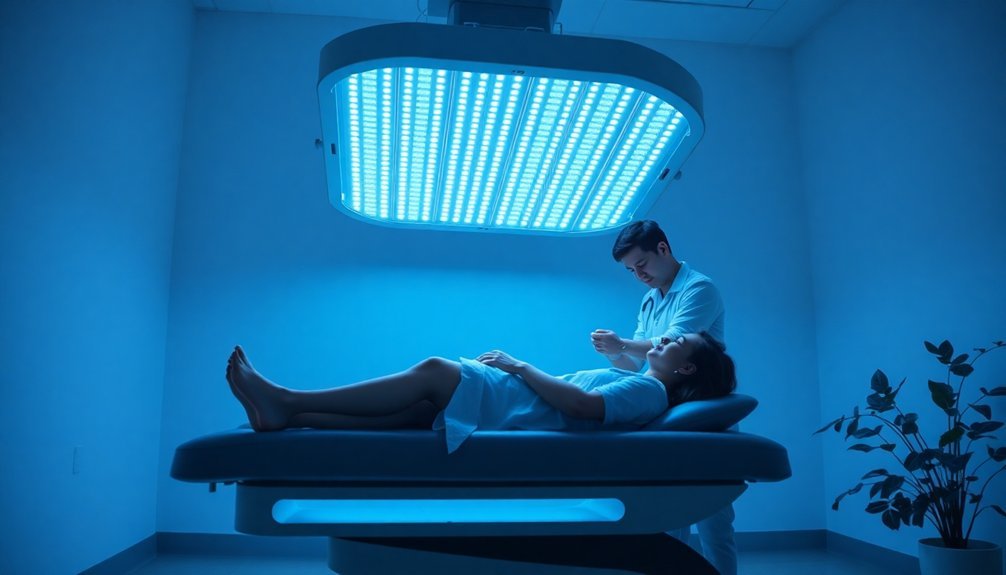



Leave a Reply